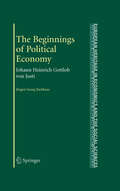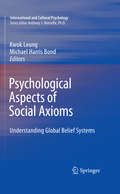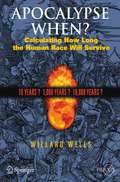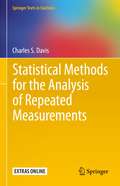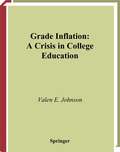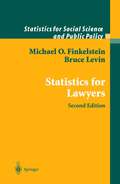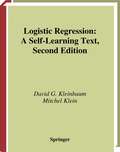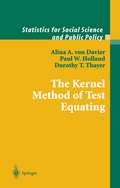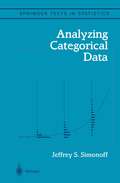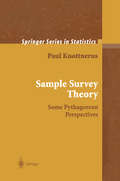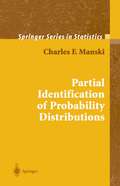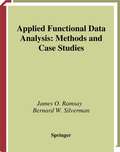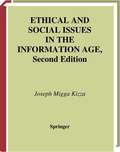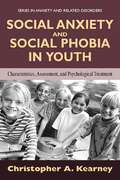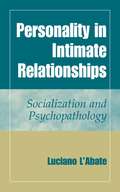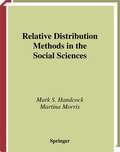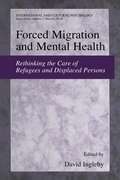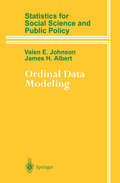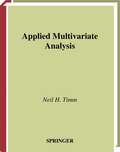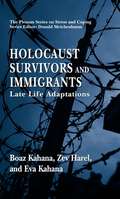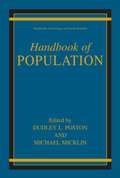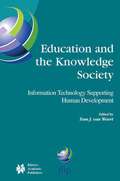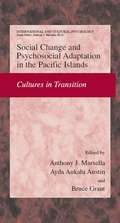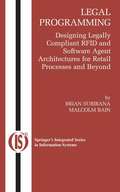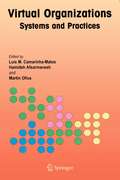- Table View
- List View
The Beginnings of Political Economy: Johann Heinrich Gottlob von Justi (The European Heritage in Economics and the Social Sciences #7)
by Jügen Georg BackhausJu¨ rgen G. Backhaus 1 Johann Heinrich Gottlob (von) Justi was born in 1702 in Bru¨ cken in Prussia (county of Sangerhausen), studied law and cameral sciences in Wittenberg and Jena, yet had to leave the university, entered the Prussian military service, was captured during the Austrian war of succession by the Austrians but escaped to Leipzig (Saxony) where he studied mineral sciences. In 1750 he was called to a chair ‘‘Cameral Sciences and Rhetorics’’ at the new Theresian Academy of Knights in Vienna. There, he gave two important inaugural lectures which are the focal point of this book. In 1754, Justi was appointed a mineral counsellor in Gottingen ¨ (Hanover), and lectured at the Saxonian University on both state sciences and natural sciences. In 1762, Frederic II (the Great) of Prussia appointed him Prussian captain (highest supervisory position) of mines and general supervisor of fiscal-mineral activities. In 1768 he was accused of embezzlement, and before he could prove his innocence, he died in 1771 as a prisoner in the (decaying) fortress of Ku¨ strin. Due to his death, the case was never decided. But Frederic had obviously made his own decision. When he appointed Justi, the appointee pointed out that he was suffering from weak eye sight and could not readily check the bookkeeping. Frederic replied: You may have weak eyes but you have a bright mind. I shall put two eyes by your side.
Psychological Aspects of Social Axioms: Understanding Global Belief Systems (International and Cultural Psychology)
by Michael Harris Bond Kwok LeungHumans are surrounded by trillions of stimuli. Their eyes, for instance, can discriminate 7,500,000 colors. But, there is a severe limitation in the number of discriminably different stimuli that they can process at one time. George Miller argued that they can handle no more than seven, plus or minus two independent pieces of information at any given time. Thus, necessarily they must develop ways to simplify the task of processing the information that exists in their environment. They do this in many ways. One way is to select the stimuli that are most imp- tant in their lives, what are often called values. Another way is to chunk stimuli by linking them to each other, so they form bundles of stimuli that can be processed as if they are one entity. Generalized expectancies of what is linked with what are beliefs, and these beliefs are structured into bundles (see Triandis, 1972).
Apocalypse When?: Calculating How Long the Human Race Will Survive (Springer Praxis Books)
by Willard WellsThis book will be a key trailblazer in a new and upcoming field. The author’s predictive approach relies on simple and intuitive probability formulations that will appeal to readers with a modest knowledge of astronomy, mathematics, and statistics. Wells’ carefully erected theory stands on a sure footing and thus should serve as the basis of many rational predictions of survival in the face of not only natural disasters such as hits by asteroids or comets, but perhaps more surprisingly from man-made hazards arising from genetic engineering or robotics. Any formula for predicting human survival will invite controversy. Dr Wells counters anticipated criticism with a thorough approach in which four lines of reasoning are used to arrive at the same survival formula. One uses empirical survival statistics for business firms and stage shows. Another is based on uncertainty of risk rates. The third, more abstract, invokes Laplace’s principle of insufficient reason and involves an observer’s random arrival in the lifetime of the entity (the human race) in question. The fourth uses Bayesian theory. The author carefully explains and gives examples of the conditions under which his principle is valid and provides evidence that can counteract the arguments of critics who would reject it entirely. His deflection of possible criticisms results from two major premises: selecting the proper random variable and “reference class” to make predictions, and the recognition that if one does not know the law that governs a process, then the best prediction that can be made is his own formula.
Statistical Methods for the Analysis of Repeated Measurements (Springer Texts in Statistics)
by Charles S. DavisA comprehensive introduction to a wide variety of statistical methods for the analysis of repeated measurements. It is designed to be both a useful reference for practitioners and a textbook for a graduate-level course focused on methods for the analysis of repeated measurements. The important features of this book include a comprehensive coverage of classical and recent methods for continuous and categorical outcome variables; numerous homework problems at the end of each chapter; and the extensive use of real data sets in examples and homework problems.
Grade Inflation: A Crisis in College Education
by Valen E. JohnsonGrade inflation runs rampant at most colleges and universities, but faculty and administrators are seemingly unwilling to face the problem. This book explains why, exposing many of the misconceptions surrounding college grading. Based on historical research and the results of a yearlong, on-line course evaluation experiment conducted at Duke University during the 1998-1999 academic year, the effects of student grading on various educational processes, and their subsequent impact on student and faculty behavior, is examined. Principal conclusions of this investigation are that instructors' grading practices have a significant influence on end-of-course teaching evaluations, and that student expectations of grading practices play an important role in the courses that students decide to take. The latter effect has a serious impact on course enrollments in the natural sciences and mathematics, while the combination of both mean that faculty have an incentive to award high grades, and students have an incentive to choose courses with faculty who do. Grade inflation is the natural consequence of this incentive system. Material contained in this book is essential reading for anyone involved in efforts to reform our postsecondary educational system, or for those who simply wish to survive and prosper in it. Valen Johnson is a Professor of Biostatistics at the University of Michigan. Prior to accepting an appointment in Ann Arbor, he was a Professor of Statistics and Decision Sciences at Duke University, where data for this book was collected. He is a Fellow of the American Statistical Association.
Statistics for Lawyers (Statistics for Social and Behavioral Sciences)
by Michael O. Finkelstein Bruce LevinDesigned to introduce law students, law teachers, practitioners, and judges to the basic ideas of mathematical probability and statistics as they have been applied in the law, the book consists of sections of exposition followed by real-world cases and case studies in which stastical data have played a role. Readers are asked to apply the theory to the facts, to calculate results (a pocket calculator is sufficient), and to explore legal issues raised by quantitative findings, while the author's own calculations and comments are given in the back of the book. The cases and case studies reflect a broad variety of legal subjects, including antidiscrimination, mass torts, taxation, school finance, identification evidence, preventive detention, handwriting disputes, voting, environmental protection, antitrust, and the death penalty. The first edition has been used in law, statistics, and social science courses, and in 1991 was selected by the University of Michigan Law Review as one of the important law books of the year. This second edition includes many new problems reflecting current developments in the law, including a new chapter on epidemiology.
Logistic Regression: A Self-Learning Text (Statistics for Biology and Health)
by David G. Kleinbaum Mitchel KleinThis is the second edition of this text on logistic regression methods, ori- nally published in 1994. As in the first edition, each chapter contains a presentation of its topic in “lecture-book” format together with objectives, an outline, key formulae, practice exercises, and a test. The “lecture-book” has a sequence of illust- tions and formulae in the left column of each page and a script (i.e., text) in the right column. This format allows you to read the script in conjunction with the illustrations and formulae that highlight the main points, formulae, or examples being presented. This second edition has expanded the first edition by adding five new ch- ters and a new appendix. The five new chapters are Chapter 9. Polytomous Logistic Regression Chapter 10. Ordinal Logistic Regression Chapter 11. Logistic Regression for Correlated Data: GEE Chapter 12. GEE Examples Chapter 13. Other Approaches for Analysis of Correlated Data Chapters 9 and 10 extend logistic regression to response variables that have more than two categories. Chapters 11–13 extend logistic regression to gen- alized estimating equations (GEE) and other methods for analyzing cor- lated response data. The appendix is titled “Computer Programs for Logistic Regression” and p- vides descriptions and examples of computer programs for carrying out the variety of logistic regression procedures described in the main text. The so- ware packages considered are SAS Version 8.0, SPSS Version 10.0, and STATA Version 7.0.
The Kernel Method of Test Equating (Statistics for Social and Behavioral Sciences)
by Alina A. Davier Paul W. Holland Dorothy T. ThayerKE is applied to the four major equating designs and to both Chain Equating and Post-Stratification Equating for the Non-Equivalent groups with Anchor Test Design. It will be an important reference for several groups: (a) Statisticians (b) Practitioners and (c) Instructors in psychometric and measurement programs. The authors assume some familiarity with linear and equipercentile test equating, and with matrix algebra.
Analyzing Categorical Data (Springer Texts in Statistics)
by Jeffrey S. SimonoffCategorical data arise often in many fields, including biometrics, economics, management, manufacturing, marketing, psychology, and sociology. This book provides an introduction to the analysis of such data. The coverage is broad, using the loglinear Poisson regression model and logistic binomial regression models as the primary engines for methodology. Topics covered include count regression models, such as Poisson, negative binomial, zero-inflated, and zero-truncated models; loglinear models for two-dimensional and multidimensional contingency tables, including for square tables and tables with ordered categories; and regression models for two-category (binary) and multiple-category target variables, such as logistic and proportional odds models. All methods are illustrated with analyses of real data examples, many from recent subject area journal articles. These analyses are highlighted in the text, and are more detailed than is typical, providing discussion of the context and background of the problem, model checking, and scientific implications. More than 200 exercises are provided, many also based on recent subject area literature. Data sets and computer code are available at a web site devoted to the text. Adopters of this book may request a solutions manual from: textbook@springer-ny.com. From the reviews: "Jeff Simonoff's book is at the top of the heap of categorical data analysis textbooks...The examples are superb. Student reactions in a class I taught from this text were uniformly positive, particularly because of the examples and exercises. Additional materials related to the book, particularly code for S-Plus, SAS, and R, useful for analysis of examples, can be found at the author's Web site at New York University. I liked this book for this reason, and recommend it to you for pedagogical purposes." (Stanley Wasserman, The American Statistician, August 2006, Vol. 60, No. 3) "The book has various noteworthy features. The examples used are from a variety of topics, including medicine, economics, sports, mining, weather, as well as social aspects like needle-exchange programs. The examples motivate the theory and also illustrate nuances of data analytical procedures. The book also incorporates several newer methods for analyzing categorical data, including zero-inflated Poisson models, robust analysis of binomial and poisson models, sandwich estimators, multinomial smoothing, ordinal agreement tables…this is definitely a good reference book for any researcher working with categorical data." Technometrics, May 2004 "This guide provides a practical approach to the appropriate analysis of categorical data and would be a suitable purchase for individuals with varying levels of statistical understanding." Paediatric and Perinatal Epidemiology, 2004, 18 "This book gives a fresh approach to the topic of categorical data analysis. The presentation of the statistical methods exploits the connection to regression modeling with a focus on practical features rather than formal theory...There is much to learn from this book. Aside from the ordinary materials such as association diagrams, Mantel-Haenszel estimators, or overdispersion, the reader will also find some less-often presented but interesting and stimulating topics...[T]his is an excellent book, giving an up-to-date introduction to the wide field of analyzing categorical data." Biometrics, September 2004 "...It is of great help to data analysts, practitioners and researchers who deal with categorical data and need to get a necessary insight into the methods of analysis as well as practical guidelines for solving problems." International Journal of General Systems, August 2004 "The author has succeeded in writing a useful and readable textbook combining most of general theory and practice of count data." Kwantitatieve Methoden "The book especially stresses how to analyze and interpret data...In fact, the highly detailed mult
Sample Survey Theory: Some Pythagorean Perspectives (Springer Series in Statistics)
by Paul KnottnerusThis book describes a novel approach to the theory of sampling from finite populations. The new unifying approach is based on the sampling autocorrelation coefficient. The author derives a general set of sampling equations that describe the estimators, their variances as well as the corresponding variance estimators. This volume will be useful for survey practitioners faced with complex surveys.
Partial Identification of Probability Distributions (Springer Series in Statistics)
by Charles F. ManskiThe book presents in a rigorous and thorough manner the main elements of Charles Manski's research on partial identification of probability distributions. The approach to inference that runs throughout the book is deliberately conservative and thoroughly nonparametric. There is an enormous scope for fruitful inference using data and assumptions that partially identify population parameters.
Applied Functional Data Analysis: Methods and Case Studies (Springer Series in Statistics)
by J.O. Ramsay B.W. SilvermanThis book contains the ideas of functional data analysis by a number of case studies. The case studies are accessible to research workers in a wide range of disciplines. Every reader should gain not only a specific understanding of the methods of functional data analysis, but more importantly a general insight into the underlying patterns of thought. There is an associated web site with MATLABr and S?PLUSr implementations of the methods discussed.
Ethical and Social Issues in the Information Age (Texts in Computer Science)
by Joseph M. KizzaThis textbook provides an introduction to the social and policy issues which have arisen as a result of information technology. Whilst it assumes a modest familiarity with computers, its aim is to provide a guide to the issues suitable for undergraduates. In doing so, the author prompts the students to consider questions such as: "What are the moral codes of cyberspace?" Throughout, the book shows how in many ways the technological development is outpacing the ability of our legal systems to keep up, and how different paradigms applied to ethical questions may often offer conflicting conclusions. As a result students will find this to be a thought-provoking and valuable survey.
Social Anxiety and Social Phobia in Youth: Characteristics, Assessment, and Psychological Treatment (Series in Anxiety and Related Disorders)
by Christopher KearneyA great bene?t of being a clinical child psychologist is the opportunity to conduct and review research on fascinating areas of human, youthful behavior. And perhaps no behavior is as central to human existence as social behavior, and the lack thereof. In writing this book, therefore, I have been doubly blessed with the chance to examine seminal works on behaviors that are so critical to the development and quality of life of children. This book covers the major historical aspects, characteristics, asse- ment strategies, and psychological treatment techniques for youths with social anxiety and social phobia. Chapter 1 provides an introduction to the related constructs and history of social phobia. Chapters 2 and 3 provide a summary of the characteristics and etiological variables that pertain most to youths with social anxiety and social phobia. Chapters 4 and 5 provide an overview of research- and clinically-based assessment strategies and recommendations for this population. Chapters 6–9 provide a description of treatment techniques that are most relevant and empirically supported for youths with social anxiety and social phobia. Chapter 10 covers issues regarding general and relapse prevention as well as dif?cult cases and future directions.
Personality in Intimate Relationships: Socialization and Psychopathology
by Luciano L'AbateFour decades of contributions to personality theory and family practice have earned Luciano L’Abate a worldwide reputation for therapeutic insights. Now he expands on his pathbreaking relational theory of personality to apply it to the twenty-first-century family in all its configurations. Personality in Intimate Relationships showcases L’Abate’s trademark elegant style and provocative ideas in his most accessible work to date.Based on Axes I and II of the DSM-IV, the book describes relationships along a readily identifiable continuum ranging from optimal functionality to severe pathology, linking the author’s conceptual framework to specific diagnostic strategies, therapeutic interventions, and prevention programs. L’Abate’s theory not only integrates individual and family theories and seemingly disparate schools of thought, but is also inclusive of nontraditional relationships—grandparent/grandchild dyads, adoptive families, same-sex couples, and others—that are often left out of the family literature.Among the key areas explored in the book:• Selfhood and self-differentiation• Confrontation and sharing of hurt feelings• Negotiating, bargaining, and problem-solving• Dealing with distance and closeness• Intimacy and the ability to love In addition, the reader is referred to complementary online appendices that supply helpful questionnaires, workbooks, and ideas for further applications.Personality in Intimate Relationships offers fresh perspective to all frontline practitioners as well as investigators in this area. It is also ideal for graduate courses in abnormal psychology and personal development.
Relative Distribution Methods in the Social Sciences (Statistics for Social and Behavioral Sciences)
by Mark S. Handcock Martina MorrisThis monograph presents methods for full comparative distributional analysis based on the relative distribution. This provides a general integrated framework for analysis, a graphical component that simplifies exploratory data analysis and display, a statistically valid basis for the development of hypothesis-driven summary measures, and the potential for decomposition - enabling the examination of complex hypotheses regarding the origins of distributional changes within and between groups. Written for data analysts and those interested in measurement, the text can also serve as a textbook for a course on distributional methods.
Forced Migration and Mental Health: Rethinking the Care of Refugees and Displaced Persons (International and Cultural Psychology)
by David InglebyAlthough forced migration is not new in human history it has become, in our time, one of the world's major problems. In the last few decades, armed conflict and political unrest have created vast numbers of asylum seekers, refugees and displaced persons. This has led, in turn to increasing involvement of professional care workers and agencies, both governmental and nongovernmental. While there is no doubt on the part of helping parties that care is necessary, there is considerable debate about the kind of care that is needed. This book presents a critical review of mental health care provisions for people who have had to leave their homeland, and explores the controversies surrounding this topic. Providing fresh perspectives on an age old problem, this book covers humanitarian aid and reconstruction programs as well as service provision in host countries. It is of interest to all those who provide health services, create policy, and initiate legislation for these populations.
Ordinal Data Modeling (Statistics for Social and Behavioral Sciences)
by Valen E. Johnson James H. AlbertOrdinal Data Modeling is a comprehensive treatment of ordinal data models from both likelihood and Bayesian perspectives. A unique feature of this text is its emphasis on applications. All models developed in the book are motivated by real datasets, and considerable attention is devoted to the description of diagnostic plots and residual analyses. Software and datasets used for all analyses described in the text are available on websites listed in the preface.
Applied Multivariate Analysis (Springer Texts in Statistics)
by Neil H. TimmThis book provides a broad overview of the basic theory and methods of applied multivariate analysis. The presentation integrates both theory and practice including both the analysis of formal linear multivariate models and exploratory data analysis techniques. Each chapter contains the development of basic theoretical results with numerous applications illustrated using examples from the social and behavioral sciences, and other disciplines. All examples are analyzed using SAS for Windows Version 8.0.
Holocaust Survivors and Immigrants: Late Life Adaptations (Springer Series on Stress and Coping)
by Boaz Kahana Zev Harel Eva KahanaBased on a unique research study, this volume examines the later life development of Holocaust survivors from Israel and the US. Through systematic interviews, the authors – noted researchers and clinicians – collected data about the lives of these survivors and how they compared to peers who did not share this experience. The orientation of the book synthesizes several conceptual approaches – gerontological and life span development, stress research, and traumatology, and also reflects the varied disciplines of the authors, spanning psychology, social work, and sociology. The result is a multi-faceted view of their subject with an understanding of the individual, society, and the interaction of the two, tempered by the authors’ own Holocaust experiences. Chapters cover a range of areas including stress and coping of these survivors, reviews of their heath and mental health, an examination of their social integration, as well as a review of the multiple predictors of psychological well-being and adaptation to aging. This book will be of interest to psychologists, social workers, sociologists, psychiatrists, and all those who study both trauma and aging.
Handbook of Population (Handbooks of Sociology and Social Research)
by Dudley L. Poston Michael MicklinThis comprehensive handbook provides an overview and update of the issues, theories, processes, and applications of the social science of population studies. The volume's 30 chapters cover the full range of conceptual, empirical, disciplinary, and applied approaches to the study of demographic phenomena. This book is the first effort to assess the entire field since Hauser and Duncan's 1959 classic, The Study of Population. The chapter authors are among the leading contributors to demographic scholarship over the past four decades. They represent a variety of disciplines and theoretical perspectives as well as interests in both basic and applied research.
Education and the Knowledge Society: Information Technology Supporting Human Development (IFIP Advances in Information and Communication Technology #161)
by Tom J. Van WeertEngineering the Knowledge Society (EKS) - Event of the World Summit on the Information Society (WSIS) This book is the result of a joint event of the World Federation of Engineering Organisations (WFEO) and the International Federation for Information Processing (IFIP) held during the World Summit on the Information Society (WSIS) in Geneva, Switzerland, December 11 - 12, 2003. The organisation was in the hands of Mr. Raymond Morel of the Swiss Academy of Engineering Sciences (SATW). Information Technology (or Information and Communication Technology) cannot be seen as a separate entity. Its application should support human development and this application has to be engineered. Education plays a central role in the engineering of Information and Communication Technology (ICT) for human support. The conference addressed the following aspects: Lifelong Learning and education,- inclusion, ethics and social impact, engineering profession, developing- society, economy and e-Society. The contributions in this World Summit event reflected an active stance towards human development supported by ICT. A Round Table session provided concrete proposals for action.
Social Change and Psychosocial Adaptation in the Pacific Islands: Cultures in Transition (International and Cultural Psychology)
by Anthony J. Marsella Ayda Aukahi Austin Bruce GrantLegal Programming: Designing Legally Compliant RFID and Software Agent Architectures for Retail Processes and Beyond (Integrated Series in Information Systems #4)
by Brian Subirana Malcolm BainLegal Programming: Designing Legally Compliant RFID and Software Agent Architectures for Retail Processes and Beyond provides a process-oriented discussion of the legal concerns presented by agent-based technologies, processes and programming. It offers a general outline of the potential legal difficulties that could arise in relation to them, focusing on the programming of negotiation and contracting processes in a privacy, consumer and commercial context. The authors will elucidate how it is possible to create form of legal framework and design methodology for transaction agents, applicable in any environment and not just in a specific proprietary framework, that provides the right level of compliance and trust. Key elements considered include the design and programming of legally compliant methods, the determination of rights in respect of objects and variables, and ontologies and programming frameworks for agent interactions. Examples are used to illustrate the points made and provide a practical perspective.
Virtual Organizations: Systems and Practices
by Luis M. Camarinha-Matos Hamideh Afsarmanesh Martin OllusThe area of Virtual Organizations as a main component of the new discipline of Collaborative Networks has been the focus of research globally. The fast evolution of the information and communication technologies and in particular the so-called Internet technologies, also represents an important motivator for the emergence of new forms of collaboration. However, the research in many of these cases is highly fragmented, considering that each project is focused on solving specific problems. As such, there is no effective consolidation/harmonization among them in order to have an effective impact and facilitate the interaction among the involved experts. This book represents a contribution to the consolidation of the already vast amount of empirical knowledge and practical experience. A synthesis of results collected from the analysis of numerous projects and industry case studies is presented, with focus on: Principles and models, ICT infrastructures and tools, Implementation issues, and Case studies.
